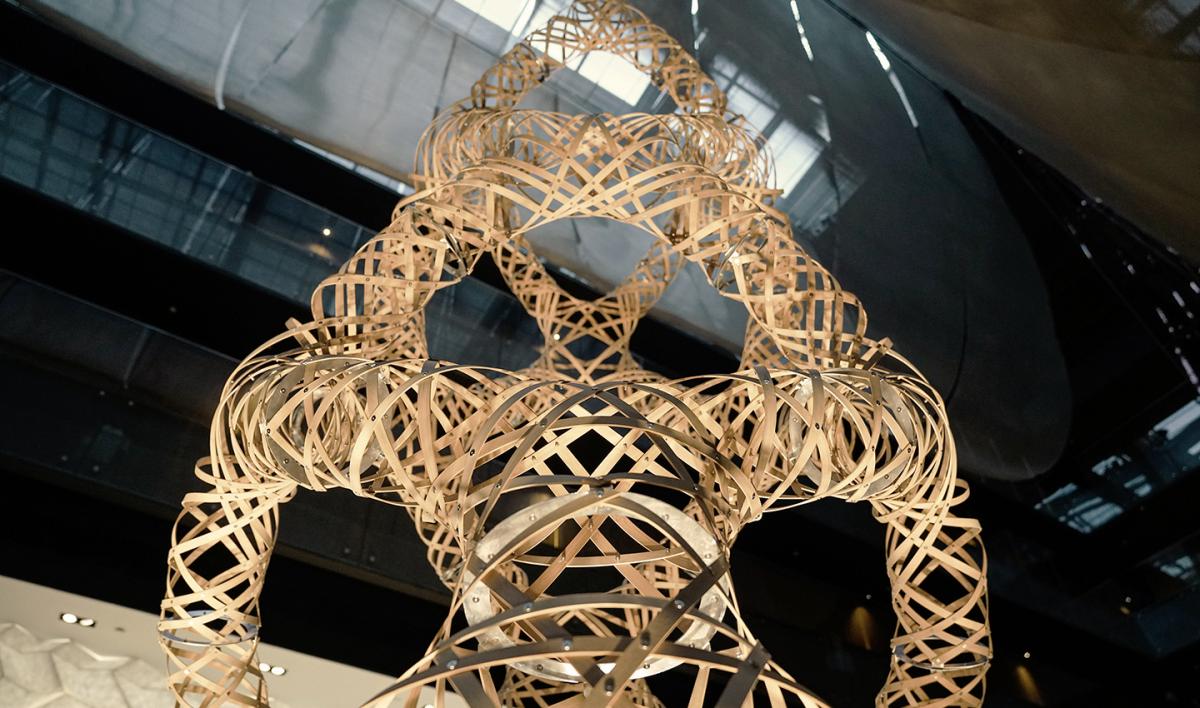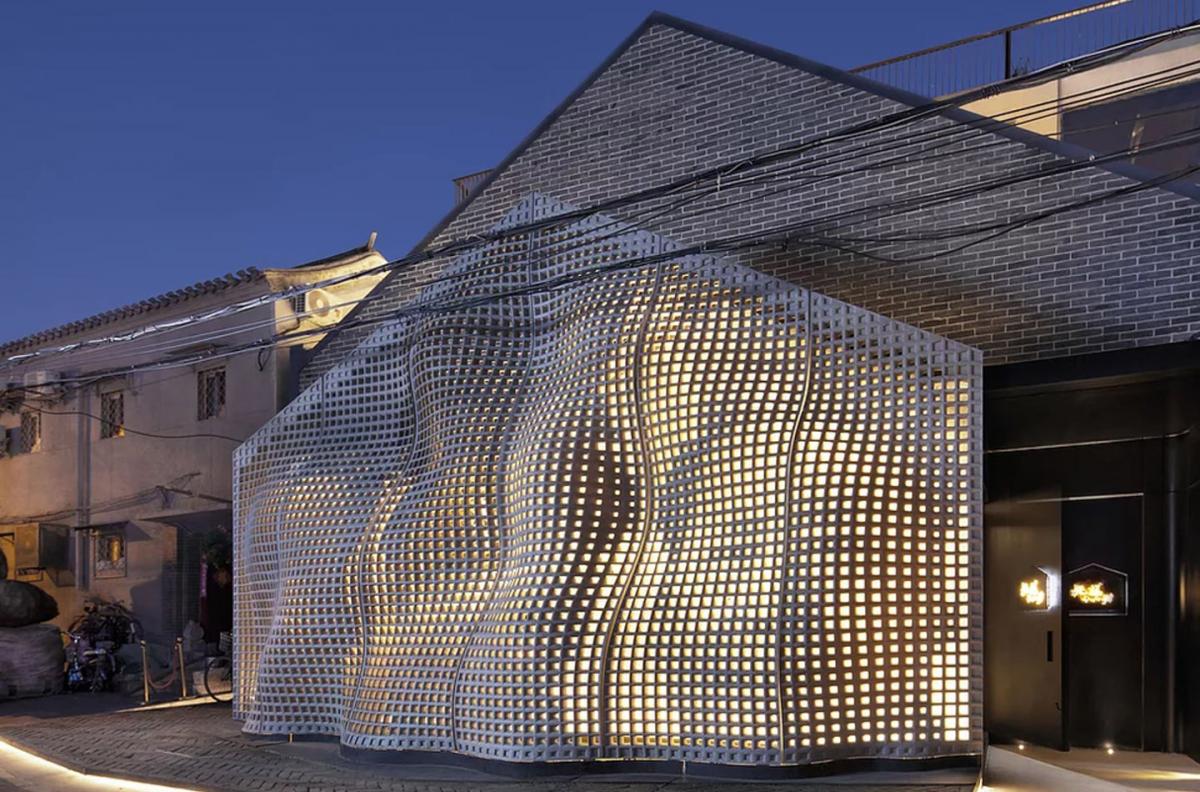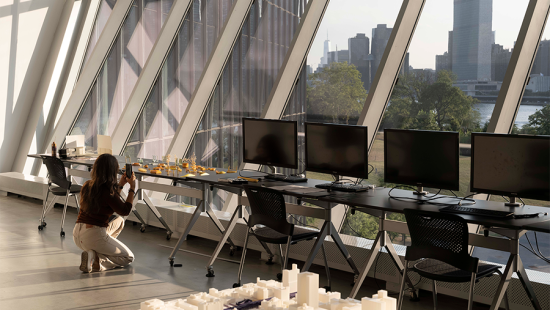Martin Miller Q&A: Architecture, Advancing Technology, and Defining Practice
by Patti Witten
Assistant Professor of the Practice in Architecture Martin Miller discusses the fast pace of working on projects in China, on collaboration and creativity, digital design tools, his advice to students today, and the thoughts that keep him up at night and inspire him in the morning.

Do you have an area of expertise as a designer? Is personal expression a component of your design practice and how do you integrate that through collaboration?
I don't have a preferred area of expertise as it applies to a particular scale or type of work. My team and I work across scales, allowing us to test ideas and prove concepts before elevating it to the next level. The installation work is often more conceptual and expressive because it is at a scale that generally offers more freedom before scaling up. We try to develop a fabrication or assembly logic that might have the potential for larger-scale works but has not yet been proven.
If I did have to define an area of expertise, it would involve the manipulation and comprehension of complexity as it applies to architectural design spatially, structurally, socially, culturally, and economically. I manage this control of complexity through the use of digital and computational tools, developing algorithms for the systemic understanding of a process or interconnected set of relationships. Computation can be used to fully comprehend and control many facets of a design process and to open potentials for more economical processes.
For example, in the Primitive Hut project with OMG!, I worked with Caroline O'Donnell and we used robotic manufacturing to make the fewest amount of cuts in fabrication, producing an ornamental quality that expresses the machining process rather than the digital artifact from which the tooling was derived. In the Ou-River Crystal Box Restaurant, we created a transformative façade suggestive of the adjacent tidal river, with ever-changing three-dimensional moiré patterns that emerge as people move around the structure.
The Antistatics team is a small group of designers who have been working together very closely for several years, gelled into one singular machine of productivity, and it is sometimes hard to tell where exactly the design is coming from.
For us, collaboration is about developing a new language between people seeking a common goal. We often need to develop new methods of drawing as expression to properly convey what we are trying to do together. This is something I first learned when working on projects as a designer for Jenny Sabin Studio and have certainly carried forward into my own practice. For me, this development of new methods of conveyance is often the most interesting part of design — which is different from engineering. Designers have to consider engineering and construction, but you have to learn the language of your collaborators to be able to properly express yourself.

What role do advanced and advancing technology have in your practice and teaching?
Technology plays an integral role in my practice. The name Antistatics comes from the idea that we are constantly seeking new methodologies for the conceptualization of architectural ideas and processes. We try to use digital design tools not as a simple stage set for the visualization of space but rather as an analog for the physical realm in which we can deeply explore assembly details or reveal previously intangible layers of information.
Digital fabrication plays an enormous role in our office and it is rapidly expanding into nearly all fields. As designers, we feel a responsibility to understand and drive its development for the future. In our office, we have a small shop of laser cutters, CNC mills, and 3D printers — a necessary part of the process of design and the creation of prototypes for our fabricators and contractors.
However, the technology that is most compelling and interesting for us is Artificial Intelligence and Big Data, two vastly undefined terms being thrown around extensively today without much understanding as to their implications. These are tools that we are still grappling with in terms of their application to architecture, but there are certainly implementations of narrow AI which we find incredibly compelling for architecture and we are exploring the application of these tools in the studios at AAP. Big Data analysis at the urban scale, for instance, is currently being explored as a means of visualizing otherwise intangible layers of information across the urban fabric, including social, cultural, economic, health, and policing.
In my current studio, we are looking at how these visualizations might be driven towards revealing gaps, deficiencies, and disparities in communities in Minneapolis with the prompt of Defunding the Police. Through further conversations with city leaders and community members, it is the goal of the studio to understand these systemic disparities within the city and provide solutions through site-specific architectural programming.

Talk about the identity of an architecture practice and how that evolves; what goes into it. Are there any challenges/advantages of working long-distance with your Antistatics partner, Mo Zheng?
The particular identity of a practice happens both through a conscious effort as well as an organic process of growth. Antistatics began as a criticism of architecture as a fixed idea — existing mantras, manifestoes, and ideals felt overly rigid to us. We were looking at robotics, automation, and kinematics as possible ways to activate architecture. Our first project was a highly kinematic and interactive piece and since we've incorporated a certain level of dynamism and progression in our work. A continuous thread is emerging, but it is really more in line with how we approach problem-solving rather than a particular aesthetic or design signature. Our approach is to seek a minima/maxima paradigm, meaning we seek to produce a dramatic and dynamic effect from a simple set of inputs. This goes back to the idea of complexity as we look for design moves to be multifaceted in their deployment.
The decision to base the office in both Beijing and Ithaca was about a desire to maintain a presence within the rigorous research environment of the university while trying to carry a lot of the less concrete ideation of academia into practice. Although the distance between our offices is certainly not ideal in many cases, we have developed and mastered digital collaboration. We've worked virtually for years, while many are just now getting used to the Zoom interface. The advantage of the 12-hour time difference between the offices is that we can have a 24-hour workflow, handing projects back and forth, and the development never really stops. In this sense, we have really been able to achieve the highly collaborative design space we were aiming for.

The Ou-River Crystal Boxes Restaurant is one building in a much larger two-kilometer waterfront masterplan, and your first large-scale built work. What project highlights, programmatic issues to solve, or other aspects were presented by it and the larger riverfront masterplan development? Has the COVID-19 pandemic affected the progress of these projects?
Despite the COVID shutdown, this year has been a particularly productive one for us and a lot of larger projects were completed during the pandemic. We came into the Ou-River waterfront project more like consultants to the original master planning team but eventually found ourselves with our hands on the wheel. Suddenly, we were presenting an entire masterplan including the design of six new buildings to the mayor and city planners of Wenzhou.
Working in China, the deadlines tend to be very tight, but the speed of design and construction feels now to be an advantage. For five years we have been working so fast and hard that it is difficult to have imagined getting so much experience in such a short time. We often don't have time to reflect before the next deadline comes up, but there is a certain rush to getting together as a team and turning around a project so quickly, seeing all the parts of the machine flying along as each person pulls for the goal.

What advice do you have for architecture students who will enter the industry in the next few years? Anything about what you are teaching this fall, and how you approach a "fall unlike any other"?
For those students who are going to be entering practice soon, my advice is to be adaptive and ready to jump at every opportunity that comes before you.
There is really no universally accepted architectural theory, parametricism, sustainability, triple-O, post-digital, contextualism, etc. The field is fairly fractured at this point as the methods and means for the production and construction of architecture are changing rapidly with the increased use of automation and robotics. I would advise students to be their own person, create their own design space to be original and unique. Enter competitions — they are a great means for setting deadlines and dealing with new briefs. Take every opportunity you can to learn something new. I had never planned to come to teach at Cornell and start a practice in Beijing, but when Jenny Sabin asked me to join the lab and her studio in Ithaca, I jumped at the chance and I am eternally grateful.
What is the most inspiring design or concept you've encountered recently?
This is a tough question, there is so much bad news in the world right now. Every day I hope for a turn in the right direction but it's more of the same. I had a conversation with Andrea Jenkins, the Minneapolis City councilwoman representing Ward 8 where George Floyd was murdered. I am originally from Minnesota and we were able to share some of our fondest memories of the Twin Cities. We also spoke about the ongoing riots, the presence of white supremacists, increased violence, homeless encampments across the city, the struggle with COVID — it is all so heartbreaking. At the same time, she is hopeful and working tirelessly to try and make change for her constituents, and that, to me is inspiring.
I work best with…my hands/a pencil/a computer.
I work best when...I've got the punch line figured out and I'm just trying to get the phrasing right.
The thought that keeps me up at night is…how we can pass this world on to the next generation.
The thought that gets me out of bed daily is…a line from an old Streetlife song, "can't stop, won't stop, don't stop, get it, get it."







